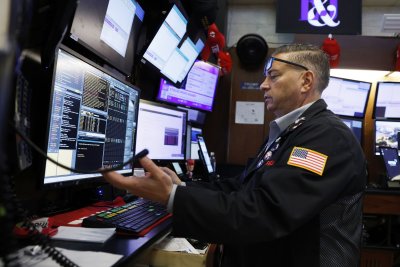
July 21 (UPI) — Two U.S. stock indexes — Standard and Poor’s 500 and Nasdaq Composite 500 — ended trading Monday with record highs as companies release earnings this week, though investors brace for U.S. tariff increases.
The S&P 500 hit a high of 6,305.60 with a rise of 8.81 points, or 0.6%, above the record 6,297.36 set Thursday. The tech-heavy Nasdaq reached 20,974.18, a rise of 78.52, or 0.38%, after a record 20,895.66 on Friday.
The blue-chip Dow Jones Industrial Average ended the day with a loss of 19.12 points, or 0.04%, to reach 44,323.07 and off the record 45,073.63 on Dec. 4. The index’s high this year was 45,008.75 on Jan. 30, 10 days after Donald Trump took office for his second term.
DJIA was in the green during the day with the other indexes higher.
Morgan Stanely Chief U.S. Equity Strategist Mike Wilson forecasts the S&P will climb to 7,200 points by mid-2026 in a report by USA Today.
The Magniciant Seven technology stocks have not released data yet with sixt of them rising Thursday Apple (0.62%0, Alphabet (2.8%), Amazon (1.43%), Meta (1.23), Microsoft (0.002%).
Declining were Nvidia (0.6% and Tesla (0.35%).
Tesla, with a stock price of 329.49 is down 13.39% year to date. The stock slumped to 221.86 on April 8, but over five years Tesla is up 247.72%.
The 11 CNBC technology sectors ended trading within a small range — from Consumer Discretionary up 0.6% to energy down 0.96%.
Earnings reports have already been strong.
Verizon’s stock price climbed 5% after posting better-than-expected earnings and revenue, and finished with a rise of 4.04%. Of the 62 S&P companies that have reported, more than 85% beat expectations, according to FactSet data as reported by CNBC.
Earnings for the second quarter, which ended June 30, are tracking 5% over one year, according Bank of America.
“Rarely do you injure yourself falling out of a basement window,” Sam Stovall, chief investment strategist at CFRA Research, said to CNBC. “With expectations so low in earnings, I think that the end result will end up being better than anticipated. That is encouraging for the market, as well.”
Stoval said he believes the S&P could hit 6,600 before declining.
“A lot of the negativity has typically been shaken out of the market during these corrections, and now we’re seeing articles about maybe the economy is not as bad as we thought it was, consumer confidence is on the mend and we’re not seeing the inflation numbers be adversely affected by tariffs,” he said. “Maybe it’s just a matter of time before those things kick in, but at least for now, I think investors are saying, ‘You know what, the market is indicating that it wants to go higher.'”
Dan Greenhaus at Solus Alternative Asset Management was more cautious. He told Bloomberg News: “Given the better-than-expected inflation and economic data — not to mention corporate commentary which thus far has been pretty good — I’m not sure I’d put too much stock in the technicals right now.”
Stocks lately haven’t been volatile, especially compared with April. Before trading this week, the S&P went 17 sessions without a move of more than 1% in each direction.
Trump threatened tariffs on the April 2 “Liberation Day” of across-the-board tariffs on most U.S. trading partners and much higher for offenders.
Indexes then tumbled to lows this year and the bond market was battered. On April 8, the S&P was down 17.5% to 4,982.77, Nasdaq went into a bear market with a decline of 23.4% to 15,267.93 and DJIA off 15.4% 37,645.59.
Then a day later, Trump paused the reciprocal tariffs to July 9. Last week, Trump announced new figures on 25 countries, including 50% against Brazil, 35% against Canada, 30% against the 29 European Union nations, 30% on Mexico.
Deals have been reached with some nations, including Britain, China and Vietnam.
Looming is the Aug. 1 trade deadline for countries to begin paying higher tariffs. Commerce Secretary Howard Lutnick told CBS News‘ Face the Nation on Sunday it is a “hard deadline.”
“That’s gotten these countries to the table, and they are going to open their markets or they’re going to pay the tariff,” Lutnick said.
The U.S. economy has been in good shape as the U.S. unemployment fell to 4.1% in June. Consumer prices rose 2.7% over one year, up 2.4% from the previous month. Transportation services were up 3.4%, food at 3%, and uses and trucks as 2.8%, according to Trading Economies. Specifically, energy costs decline by a smaller margin than the previous month.
“I think you’re going to see inflation stay right where it is,” Lutnick said. “Americans can expect ‘shockingly low’ prices.
The federal fund rate remained at a target range of 4.25% to 3.5% after its the Federal Reserve’s June 17 and 18 meetings.
The Fed’s last rate change was a 25 basis point reduction on Dec. 18.
Trump has been pressuring Chairman Jerome Powell to lower the rates. But Powell is urging caution and said a reduction could spur inflation and slow economic growth.
The U.S. 10-year Treasury was down to 4.382%.
Gold COMEX for August traded at 3,410.30, a rise of $52, which is below the record 3,452.80 on June 13.
West Texas Intermediate Crude for August settled at $67.00, a decline of 34 cents. On May 5, it was $57.13, the lowest since January 2021. One ounce of gold had a high of $80.04 on Jan. 15.
The price of a gallon of unleaded gasoline was averaging $3.14 nationwide, down a penny from last week, according to AAA on Monday. One year ago it was $3.50.